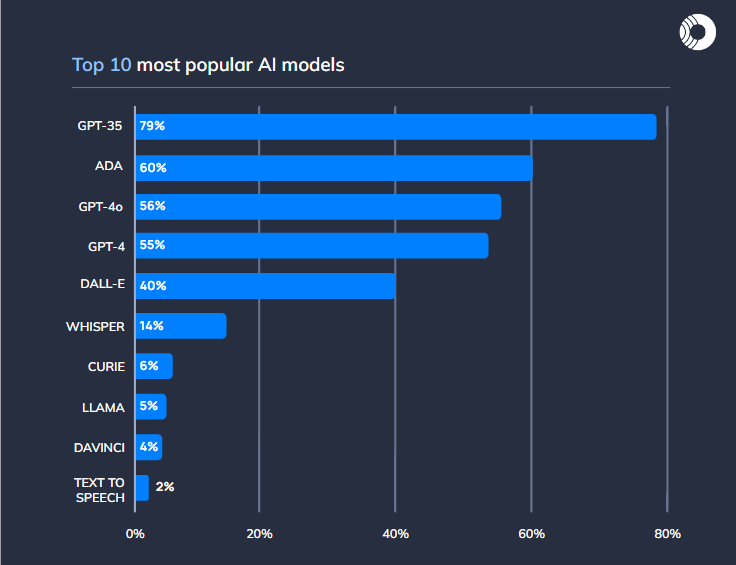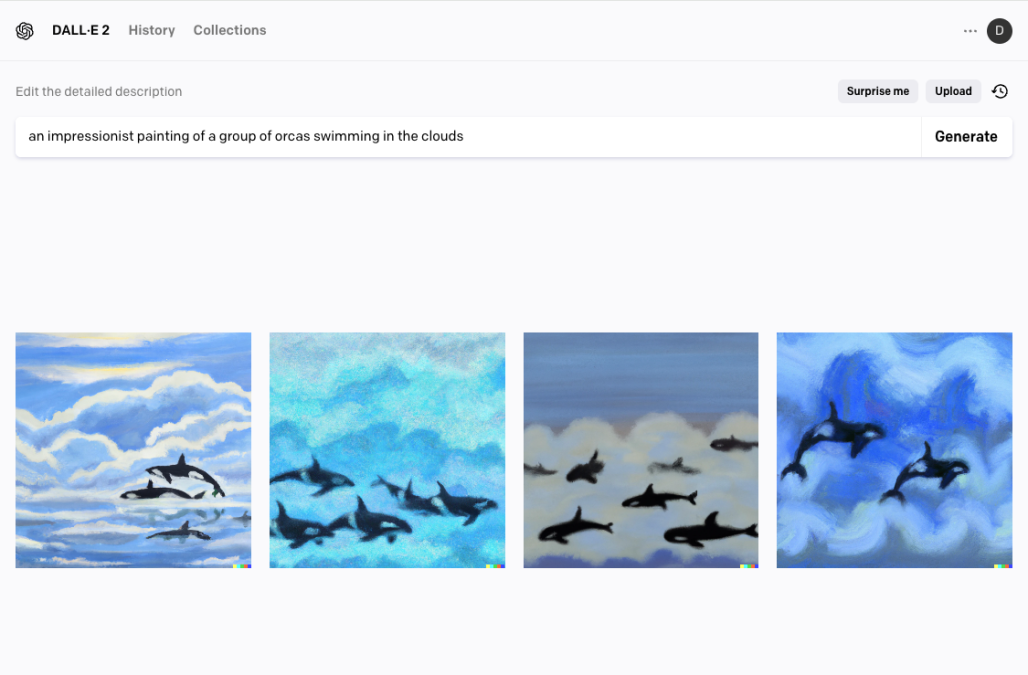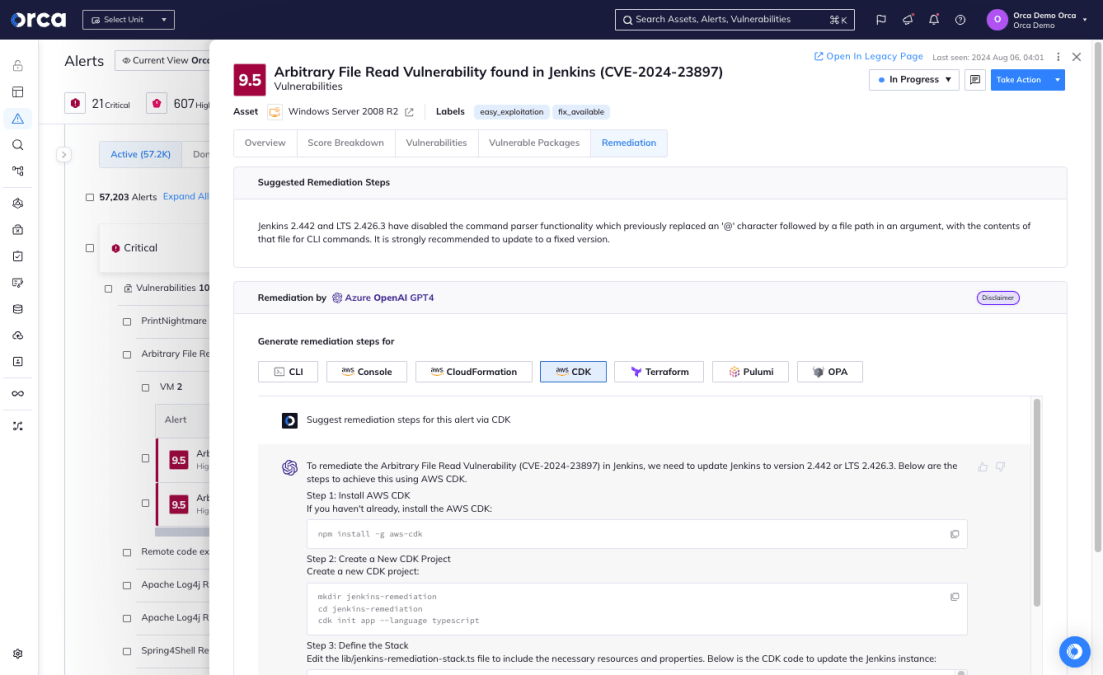Looking for the latest rankings? Check out our updated list of the 10 Most Popular AI Models of 2025.
Gartner predicts that the AI software market will reach nearly $298 billion by 2027, sustaining a compound annual growth rate of 19.1%. Estimates like these point to the significant business opportunities organizations are seeing in AI. Yet capitalizing on the promise of AI calls for a deeper understanding of the technology—especially AI models. These models vary significantly in terms of their intelligence, capability, and performance in a specific domain.
In this post, we explore the 10 most popular AI models of 2024 based on research of millions of cloud assets by the Orca Research Pod.
What are AI models?
Put simply, an AI model is a computer program designed to perform a specific task autonomously based on learned patterns and relationships. Numerous types of models exist, each better suited for a particular application. AI models mimic aspects of human intelligence and cognition, such as problem-solving and learning.
AI models work in tandem with AI services and AI packages. AI services are solutions offered by cloud providers that enable organizations to use or develop AI applications in their cloud environments. AI packages, on the other hand, are programs that accelerate the training, customization, and performance of AI models. Each AI service offers multiple AI models and packages for organizations to choose from.
Most used AI models
Below, we explore the 10 most popular AI models used in cloud environments, including the features and benefits of each. Notably, OpenAI developed nine of the models in this list.

#1. GPT-3.5
Taking first place in our list, GPT-3.5 represents the most popular AI model, with 79% of organizations deploying the model in their cloud environments.
OpenAI first introduced GPT-3.5 in November 2022 as the successor to GPT-3. GPT-3.5, as the underlying model of ChatGPT today, can handle a wide scope of simple tasks. It can understand and generate human-like text, concisely summarize long-form text, translate text between languages fluently, provide relevant information when prompted, and more.
#2. Ada
Next up is Ada, the second most popular AI model, used by 60% of organizations using it. Also developed by OpenAI, Ada first emerged as one of four GPT-3 models (along with Davinci, Babbage, and Curie).
Of the four, Ada is the fastest, and least expensive but also the least capable. It can handle a variety of text-generation tasks, such as parsing text, reformatting text, and performing simple classification tasks.
#3. GPT-4o
GPT-4o rounds out the top three in this list, with 56% of organizations using the model. Introduced in May 2024, GPT-4o represents OpenAI’s most advanced model released to date, superseding GPT-4.
An intelligent model, it can handle a variety of complex tasks, including synthesizing inputs of text, audio, and/or images and generating outputs in any of those formats (what’s known as multimodal reasoning and generation). Additionally, it can handle real-time verbal interaction and produce audio that sounds like a human. GPT-4o can perform a number of other tasks such as sentiment analysis, image and video analysis, and more.
#4. GPT-4
Not to be confused with the previous model, GPT-4 represents the fourth most popular AI model with 55% of organizations actively deploying it in their cloud environments.
Introduced in March 2023 by Open AI, the model supersedes GPT-3.5 and can handle complex tasks as a high-intelligence model. Like GPT-4o, it offers multimodality (ability to accept images as inputs). It also offers enhanced safety features to prevent misuse or abuse of the service, as well as an enlarged context window compared to its predecessors.
#5. DALL-E
DALL-E rounds out the top five, with 40% of organizations deploying it in their cloud estate. Developed by OpenAI and introduced in January 2021, DALL-E generates art and realistic images from descriptions in plain language.
The AI model enables organizations to create mock-ups of technical products, create more tailored marketing content that replaces stock imagery, help with brand design, and more.

#6. Whisper
Whisper takes the sixth place spot with 14% of organizations deploying it in their cloud environments. Unsurprisingly, OpenAI developed this model as well, which it introduced in September 2022.
Whisper converts audio into text, transcribing large files (up to 25MB). Whisper also can translate audio from one language to another and transcribe it.
#7. Curie
Curie lands in seventh place, with 6% of organizations using it. Referenced previously, the model belongs to the family of GPT-3 models introduced by OpenAI (including Davinci, Babbage, and Ada).
Compared to those models, Curie performs well in handling nuanced tasks like sentiment classification and summarization. It also performs well at answering questions and serving as a chatbot for general queries.
#8. Llama
Llama takes the eighth spot, with 5% of organizations deploying it. Developed by Meta AI, Llama was first released in February 2023 and became an open-source family of AI models capable of handling a variety of tasks—from simple to complex.
Llama handles text analysis and summarization, coding, translation generation, advanced reasoning and decision-making, multi-step tasks, and more.
#9. Davinci
Davinci takes the ninth spot, with 4% of organizations deploying it. Along with Curie, Ada, and Babbage, Davinci is one of four GPT-3 models introduced by OpenAI.
Among the GPT-3 models, Davinci is the most capable, performing more complex tasks with less instruction. The model can solve logic problems, perform cause and effect analysis, produce creative content, and summarize complex content.
#10. Text to Speech (TTS)
Text to Speech rounds out the top 10, with 2% of organizations deploying the model in their environments.
Developed by OpenAI, Text to Speech (TTS) converts text to natural-sounding, real-time audio. TTS offers six voices and the ability to produce audio in multiple languages.
2024 State of AI Security Report
The usage data on the top 10 AI models was published in Orca’s 2024 State of the AI Security Report. In addition to usage data on AI models, services and packages, the report uncovers AI security risks in actual production environments spanning AWS, Azure, Google Cloud, Oracle Cloud, and Alibaba Cloud. Read more in the State of AI Security blog or download the full report.
AI models used by the Orca Cloud Security Platform
So which AI models does Orca use? In January 2023, the Orca Cloud Security Platform became the first Cloud-Native Application Protection Platform (CNAPP) to integrate with GPT-3 and leverage AI to enhance risk detection, simplify investigations, and streamline remediations.

Since then, Orca has announced integrations with GPT-4 and GPT-4o, and expanded its AI capabilities to enable teams to discover cloud assets and risks using plain language searches in more than 50 languages.

Orca also launched its AI Security Posture Management (AI-SPM) capabilities, which offer full visibility and insight into AI risks and covers more than 50 AI models and packages, ensuring organizations can securely innovate at scale.
To learn more about how Orca can help you fortify your AI security in the cloud, schedule a personalized 1:1 demo.





